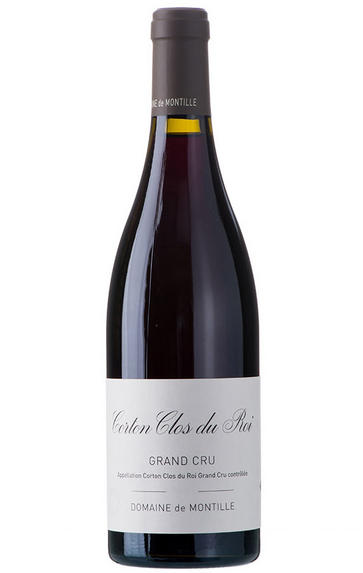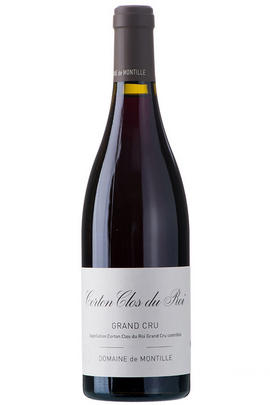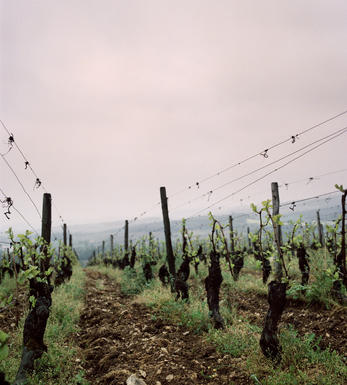
2018 Corton, Clos du Roi, Grand Cru, Domaine de Montille, Burgundy

Critics reviews
Dense dark purple with lush sweet fruit. A little bit of bramble jelly in the fruit profile, with a drier finish. Far from top-heavy and not showing heat at the finish. Just a little barrel toast. I think this will knit together well, but it is not quite in place at the moment.
Drink from 2032 onward
Jasper Morris MW, InsideBurgundy.com (September 2022)
From 75+ year old vines; 66% whole clusters.
An exceptionally spicy nose also reflects plenty of floral elements along with notes of ripe but cool black cherry and plum. I very much like the sense of energy to the middle weight flavors that are not particularly dense but possess a lovely texture along with good minerality that suffuses the youthfully austere, highly complex and beautifully long finish. This too is excellent.
Drink from 2035 onward
Allen Meadows, Burghound.com (April 2020)
The 2018 Corton Clos du Roi Grand Cru includes two-thirds whole bunch this year, and it is very well integrated into the blackberry and raspberry fruit. There is fine detail here. The palate is medium-bodied with crisp tannins, quite focused and full of tension. The detailed, saline, white-pepper-tinged finish lingers in the mouth. Recommended.
Drink 2022 - 2044
Neal Martin, Vinous.com (January 2020)
About this WINE

Domaine de Montille
The De Montille family has long been a venerable one in Burgundy, though Domaine de Montille’s reputation was properly established in 1947: prominent Dijon lawyer Hubert de Montille inherited 2.5 hectares in Volnay, later adding further parcels in Volnay, Pommard and Puligny. Hubert’s style was famously austere: low alcohol, high tannin and sublime in maturity.
His son, Etienne, joined him from ’83 to ’89 before becoming the senior winemaker, taking sole charge from ’95. Etienne also managed Château de Puligny-Montrachet from ’01; he bought it, with investors, in ’12.
The two estates were separate until ’17, when the government decreed that any wine estate bearing an appellation name could no longer offer wine from outside that appellation.
The solution was to absorb the château estate into De Montille – the amalgamated portfolio is now one of the finest in the Côte d’Or.
Etienne converted the estate to organics in ‘95, and to biodynamics in 2005, making the house style more generous and open, focusing on the use of whole bunches for the reds.

Corton-Charlemagne
There are two specific Charlemagne vineyards, En Charlemagne and Le Charlemagne, making up half the Corton-Charlemagne appellation, while white grapes grown in seven other vineyards (see list below) may also be sold as Corton-Charlemagne. As a result there can be a wide divergence in style between a south-facing location such as Pougets, which needs picking right at the start of the harvest, and the western slopes in Pernand-Vergelesses which might be picked several weeks later. The underlying similarity though comes from the minerality of the soil.
En Charlemagne lies at the border with Aloxe-Corton. The hillside faces west and fine, racy white wines can be made, but the Grand Cru appellation has been extended right up to the village of Pernand itself, by which time the exposition is north-west and the valley has become noticeably more enclosed. The final sector was only promoted in 1966, and probably should not have been.
Le Charlemagne is the absolute heartland of the appellation, facing south-west, thus avoiding the risk of over-ripeness which can afflict the vines exposed due south. If I had Corton-Charlemagne vines here I would be tempted to let the world know by labelling the wine as Corton-Charlemagne, Le Charlemagne.
Two producers to my knowledge also have some Pinot Noir planted here – Follin-Arbelet and Bonneau du Martray. Both make attractive wines but neither, to my mind, justifies Grand Cru status for red wine, lacking the extra dimensions of flavour one hopes for at the highest level. This is not the producers’ fault, but a reflection of the terroir.

Pinot Noir
Pinot Noir is probably the most frustrating, and at times infuriating, wine grape in the world. However when it is successful, it can produce some of the most sublime wines known to man. This thin-skinned grape which grows in small, tight bunches performs well on well-drained, deepish limestone based subsoils as are found on Burgundy's Côte d'Or.
Pinot Noir is more susceptible than other varieties to over cropping - concentration and varietal character disappear rapidly if yields are excessive and yields as little as 25hl/ha are the norm for some climats of the Côte d`Or.
Because of the thinness of the skins, Pinot Noir wines are lighter in colour, body and tannins. However the best wines have grip, complexity and an intensity of fruit seldom found in wine from other grapes. Young Pinot Noir can smell almost sweet, redolent with freshly crushed raspberries, cherries and redcurrants. When mature, the best wines develop a sensuous, silky mouth feel with the fruit flavours deepening and gamey "sous-bois" nuances emerging.
The best examples are still found in Burgundy, although Pinot Noir`s key role in Champagne should not be forgotten. It is grown throughout the world with notable success in the Carneros and Russian River Valley districts of California, and the Martinborough and Central Otago regions of New Zealand.


Buying options
Add to wishlist
Description
As is typical, whole bunches make up two-thirds this year, with new oak maintained at around 50%. The vines are almost 85 years old, providing an intensity and elegance to this wine, which has a ferrous and meaty middle, but a beautifully delineated and elegant finish.
Drink 2025 - 2035
Berry Bros. & Rudd
wine at a glance
Delivery and quality guarantee